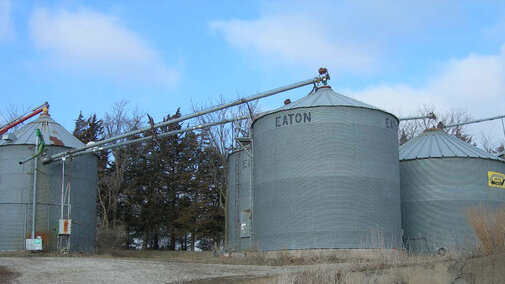Farmers are finishing harvest as we transition from a nice warm fall to cooler temperatures and precipitation coming as snow. Following is some guidance on drying and storage during this transition.
Natural Air Drying
In-bin air-drying becomes inefficient as outdoor air temperatures decrease. Turn the drying fans off when outside temperatures average below about 40°F. Transition to cooling the grain for winter storage. Do not operate the fans when it is raining, snowing, or foggy.
Cooling Stored Grain
The grain should be cooled whenever the average outdoor temperature is 10 to 15 degrees cooler than the grain. It should be cooled to near or below 30°F for winter storage in the northern states. Cool grain with aeration to reduce the insect infestation potential. Insect reproduction is reduced at temperatures below about 60°F. Insects are dormant below about 50°F, and can be killed by extended exposure to temperatures below about 30°F.
Cooling grain as outdoor temperatures cool reduces moisture migration and the condensation potential near the top of the grain pile. In addition, grain moisture content and temperature affect the rate of mold growth and grain deterioration, with the allowable storage time approximately doubling with each 10-degree reduction in grain temperature.
Storing in Bags
Storing grain in poly bags is a good option, but it does not prevent insect infestations or mold growth in damp grain. Grain placed in bags should be dry and cool. Recommendations include:
- Placing grain in bags at recommended storage moisture contents based on grain and outdoor temperatures. Corn can be stored at 15% to 18% as long as the corn is near or below 30°F going into storage and average outdoor temperatures are near or below 30°F. Corn that will be stored into spring and early summer should be at 14% moisture or lower.
- Heating and grain deterioration will occur if the grain exceeds a safe storage moisture content, and grain in a bag cannot be cooled with aeration. The average temperature of dry grain will follow the average outdoor temperature.
- Selecting an elevated, well-drained site for the storage bags.
- Preparing the ground surface so the bag is not punctured during placement.
- Placing the bags, north and south, so solar heating is similar on both sides. Sunshine on just one side heats that side, which can lead to moisture accumulation in the grain on the cool side.
- Monitoring the grain temperature at several places in the bags. Wildlife can puncture the bags, creating an entrance for moisture and releasing the grain smell, which attracts more wildlife.
Grain Piles
Grain frequently is stored short term in outdoor piles. However, precipitation is a severe problem in uncovered grain. Just a 1-inch rain will increase the moisture content of a 1-foot layer of corn by 9 percentage points. This typically leads to the loss of at least 2 feet of grain on the pile surface. Snow on the pile may melt and wet the grain, or mix with the grain during unloading. A 1-foot loss on the surface of a 25-foot-high cone-shaped pile is about 13% of the grain.
This is a loss of $39,000 if the grain value is $4 per bushel. If creating outdoor piles:
- Use a cover to prevent water infiltration. A combination of restraining straps and suction from the aeration system holds grain covers in place. Aeration and wind blowing on the pile will not dry wet grain adequately to prevent spoilage.
- Place the pile so the storage floor is higher than the surrounding ground to minimize moisture transfer from the soil into the grain and assure that there is good drainage around the pile.
- Properly sized and spaced ducts should be placed on the ground under the pile to pull air through the grain. Place perforated ducts on the grain under the cover to provide a controlled air intake for the aeration system and provide airflow near the cover to minimize condensation problems.
For more information, see
- Grain Storage Management in CropWatch
- North Dakota State University Grain Drying and Storage information
Author Note
Guest CW contributor Ken Hellevang is a professor and Extension Engineer in the Agricultural and Biosystems Engineering Department at North Dakota State University.

